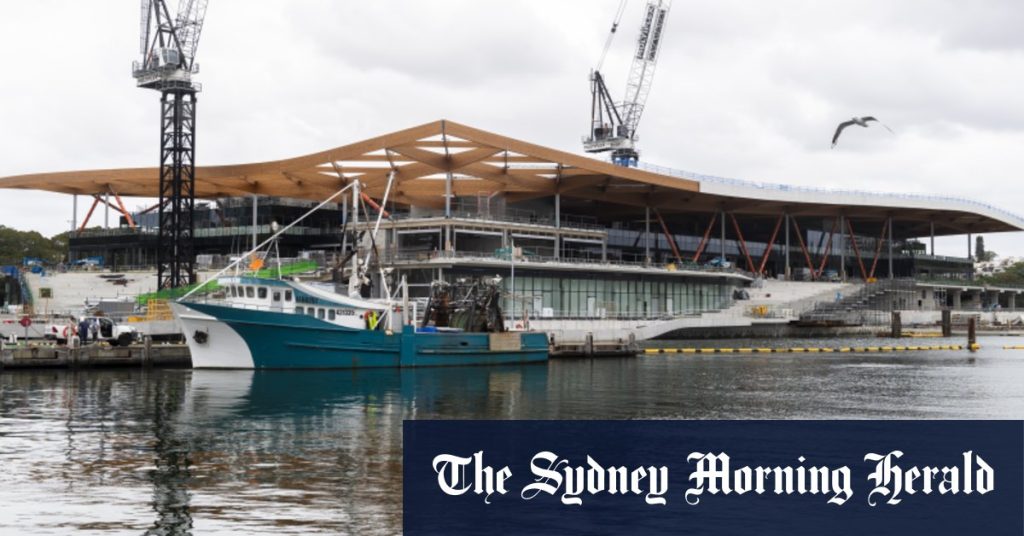The New South Wales government is undertaking a significant overhaul of Sydney’s maritime infrastructure, highlighted by the construction of a new ferry wharf at the soon-to-be-opened Sydney Fish Market. This wharf, envisioned as a crucial component of the revitalized fish market, is expected to become a major attraction for tourists and locals alike, rivaling the iconic Manly ferry in popularity. The wharf’s strategic location within the revamped fish market complex aims to seamlessly integrate ferry transport with the market experience, offering convenient access for visitors arriving by water. The wharf development forms part of a broader initiative to enhance Sydney’s ferry network and promote sustainable transportation options.
The infrastructure surrounding the new fish market comprises a comprehensive network of wharves, catering to both the fishing industry and public transportation. Eight wharves are designated for the fishing fleet, providing dedicated berthing spaces for commercial vessels. In addition, a longer recreational wharf will serve multiple purposes, accommodating public drop-off points, short-term stays for private vessels, mooring for the fishing fleet, and, crucially, a dedicated ferry stop. This multi-functional wharf will be strategically positioned near the existing fish market, while the eight fishing wharves will be located on the western side of the new building. This layout aims to optimize operational efficiency and minimize disruption between commercial fishing activities and public access.
Complementing the new ferry wharf, the NSW government is also exploring ways to improve public transport connectivity to the new fish market. This includes considering additional services on the L1 Dulwich Hill light rail line, recognizing the tram’s vital role in linking the market to the wider transport network. Furthermore, the names of nearby light rail stops will be updated to reflect the relocation of the fish market, providing clearer guidance for commuters. These integrated transport improvements aim to ensure seamless and convenient access to the new market for both locals and visitors, regardless of their chosen mode of transport.
The development of the new fish market ferry wharf coincides with the government’s ongoing efforts to modernize and electrify the state’s ferry fleet. The first of seven new Parramatta River-class electric ferries is expected to arrive soon, marking a significant step towards replacing the older Rivercats. This investment in electric ferries aligns with the government’s broader commitment to sustainable transport and reducing emissions. The long-term goal is to replace all diesel-powered ferries in the state’s 40-vessel fleet with locally built electric or hydrogen-powered vessels by 2035, demonstrating a commitment to environmentally friendly public transportation.
While the new fish market ferry wharf is eagerly anticipated, separate ferry infrastructure projects are encountering challenges. Two new ferry wharves near the entrance to Botany Bay, at La Perouse and Kurnell, are nearing completion and are set to open in February. However, the commencement of regular ferry services between these locations faces an indeterminate delay. Despite the substantial $78 million investment in the wharves, the government has yet to secure a commercial operator for the route. Efforts to engage potential operators, including river taxis and the local land council, have so far been unsuccessful, highlighting the difficulties in establishing commercially viable ferry services in certain areas.
The contrasting fortunes of the fish market ferry wharf and the Botany Bay wharves underscore the complexities of developing and operating ferry services. While the fish market wharf benefits from its integration into a major attraction and its connection to existing transport networks, the Botany Bay wharves face the challenge of attracting sufficient demand to support a commercially viable service. This highlights the need for careful consideration of market demand and operational feasibility when planning ferry infrastructure projects. The NSW government’s ongoing investment in ferry infrastructure reflects a commitment to enhancing connectivity and promoting sustainable transport options, but the success of these endeavors depends on a variety of factors, including public demand and the availability of suitable operators.

